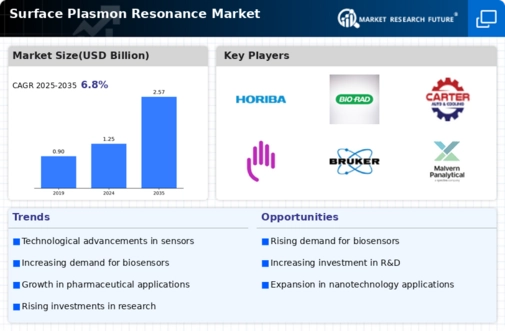Market Growth Projections
The Global Surface Plasmon Resonance Market Industry is projected to experience substantial growth, with estimates indicating a market value of 1.25 USD Billion in 2024 and a potential increase to 2.57 USD Billion by 2035. This growth trajectory suggests a compound annual growth rate (CAGR) of 6.79% from 2025 to 2035. Such projections reflect the increasing adoption of surface plasmon resonance technology across various sectors, including healthcare, pharmaceuticals, and environmental monitoring. The anticipated growth is driven by advancements in technology, rising demand for biosensors, and a growing emphasis on personalized medicine, positioning the market for a promising future.
Rising Demand for Biosensors
The increasing demand for biosensors in various applications, including healthcare and environmental monitoring, drives the Global Surface Plasmon Resonance Market Industry. Biosensors are crucial for real-time monitoring of biological interactions, and their integration with surface plasmon resonance technology enhances sensitivity and specificity. For instance, the healthcare sector is witnessing a surge in the need for rapid diagnostic tools, which utilize surface plasmon resonance for detecting biomolecules. This trend is expected to contribute significantly to the market, with projections indicating a market value of 1.25 USD Billion in 2024, reflecting the growing reliance on advanced biosensing technologies.
Technological Advancements in SPR
Technological advancements in surface plasmon resonance systems are propelling the Global Surface Plasmon Resonance Market Industry forward. Innovations such as portable SPR devices and enhanced imaging techniques are making this technology more accessible and user-friendly. These advancements facilitate a broader range of applications, from drug discovery to food safety testing. For example, the development of miniaturized SPR sensors allows for on-site testing, which is particularly beneficial in remote areas. As these technologies evolve, they are expected to attract more investments, potentially leading to a market growth rate of 6.79% from 2025 to 2035, ultimately reaching a value of 2.57 USD Billion by 2035.
Growing Focus on Personalized Medicine
The growing focus on personalized medicine is influencing the Global Surface Plasmon Resonance Market Industry positively. Personalized medicine aims to tailor treatments based on individual patient profiles, necessitating advanced diagnostic tools to monitor therapeutic responses. Surface plasmon resonance technology plays a pivotal role in this domain by enabling the analysis of biomolecular interactions at a high resolution. This capability is particularly valuable in oncology, where understanding the interaction between drugs and cancer biomarkers is crucial. As healthcare systems increasingly adopt personalized approaches, the demand for SPR technology is expected to rise, contributing to the overall market expansion.
Increasing Research and Development Activities
The surge in research and development activities across various scientific fields is a key driver for the Global Surface Plasmon Resonance Market Industry. Academic institutions and research organizations are increasingly utilizing SPR technology to explore molecular interactions and develop new therapeutic agents. This trend is evident in the pharmaceutical industry, where SPR is employed to assess drug-target interactions, thereby expediting the drug development process. The emphasis on R&D is likely to foster collaborations between academia and industry, further enhancing the adoption of SPR technology. As a result, the market is poised for significant growth, supported by ongoing innovations and discoveries.
Regulatory Support for Advanced Diagnostic Tools
Regulatory support for advanced diagnostic tools is fostering growth in the Global Surface Plasmon Resonance Market Industry. Governments and regulatory bodies are recognizing the importance of innovative diagnostic technologies in improving patient outcomes and public health. Initiatives aimed at streamlining the approval process for SPR-based devices are likely to encourage manufacturers to invest in this technology. For instance, regulatory frameworks that facilitate faster market entry for SPR diagnostics can significantly enhance their adoption in clinical settings. This supportive environment is expected to drive market growth, as more companies seek to develop and commercialize SPR-based solutions.


 Source: Secondary Research, Primary Research, Market Research Future Database and Analyst Review
Source: Secondary Research, Primary Research, Market Research Future Database and Analyst Review






Leave a Comment